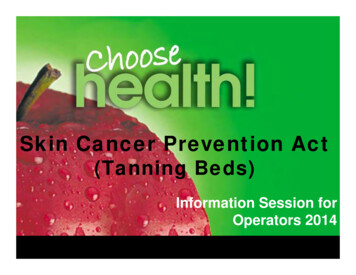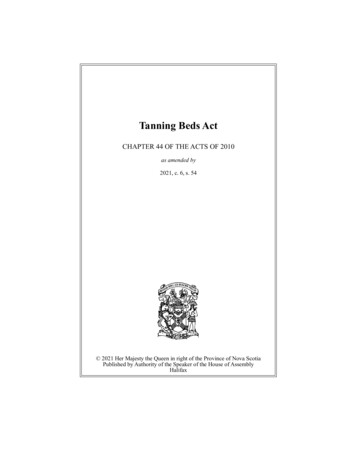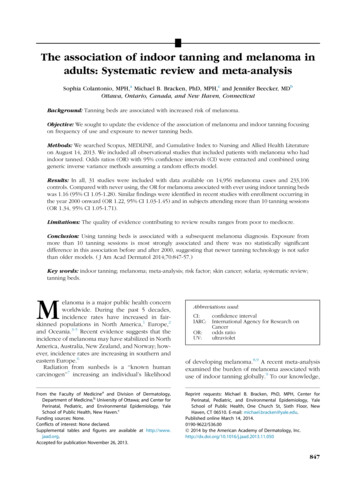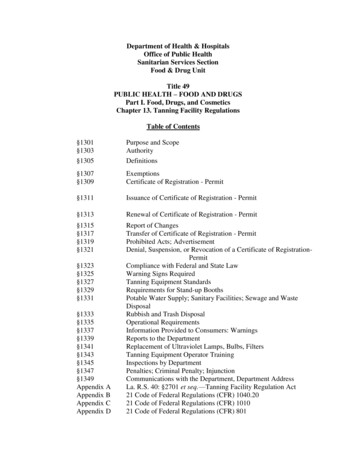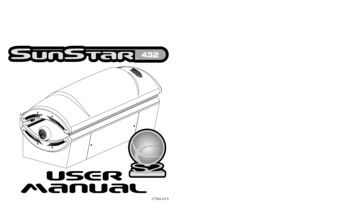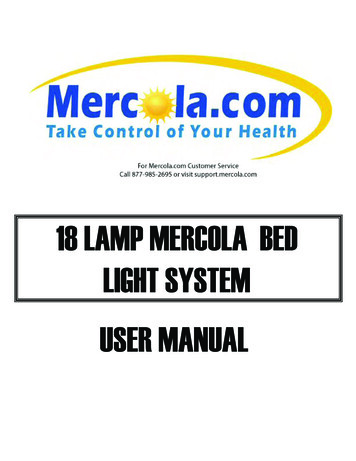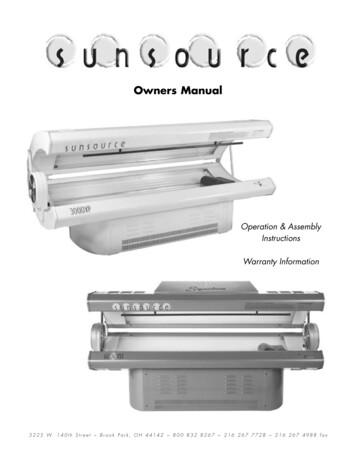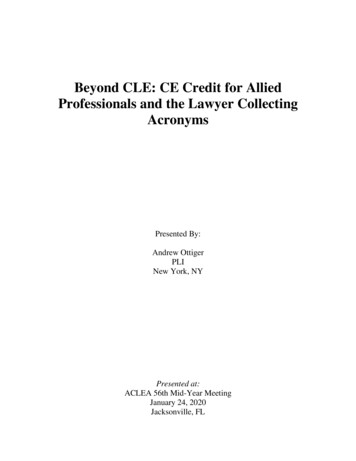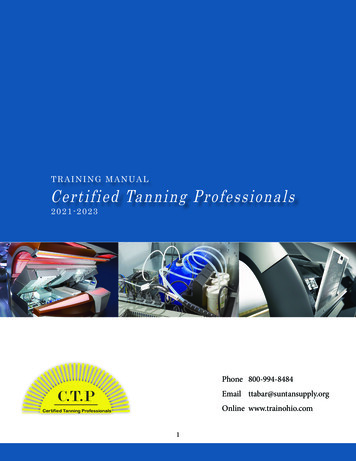
Transcription
TRAINING MANUALCertified Tanning Professionals2021-2023Phone 800-994-8484Email ttabar@suntansupply.orgOnline www.trainohio.com1
IntroductionAbout Suntan SupplyOUR MISSION, Suntan Supply will continue to fulfill all of your tanning needs through our professionalstaff, quality service, and ability to satisfy your expectations in an expedient manner.Certified Trainers:Martin F. Gallaghermarty@suntansupply.orgWilliam E. Gallagherbgallagher@suntansupply.orgJohn Eliasjelias@suntansupply.org2
Table of ContentsChapter One: State RegulationsChapter Nine: Tanning Bed Lamps Board of cosmetology state regulations How lamps work Stare control office Lamp compatibility Types of lampsChapter Two: Federal Regulations Sun lamp products and ultraviolet raysChapter Ten: Ultraviolet Radiation Performance standards for light-emitting products What is UVA & UVB lightChapter Three: Skin CareChapter Eleven: Tanning Beds Sunless tanning History of indoor tanning Sunblock and sunscreen Types of tanning bedsChapter Four: MoisturizingChapter Twelve: Photosensitizers Aloe Photoreactions Benefits of moisturizing Photoallergies’ Good vs bad in alcohol in cosmetic formulas Photophobia PhotoreactionsChapter Five: Skin Knowing your skinChapter Thirteen: Eye Protection Fitzpatrick skin typing Why you need to protect your eyes from the sun Effects of the skin How can my eyes be protected from the sunChapter Six: Red LightChapter Fourteen: Customer Rapport What is red light Building a rapport with customers Benefits of red light Customer complaints Indoor tanning association letter on red lampsChapter Fifteen: MaintenanceChapter 7: The Tanning Process Maintenance records Epidermis Heavy duty maintenance IPD & PPD 16 steps to maintenanceChapter Eight: LotionsReferences What is tanning lotion Indoor vs. outdoor lotion Types of tanning bed lotions3
Chapter 1State Regulations(1) DEFINITION OF BOARD OF COSMETOLOGYThe term “board” means the Ohio state board of cosmetology. The term “board member” means those members appointedby the governor of the state in accordance with Chapter 4713. Of the Revised Code who are vested with both statutory anddiscretionary authority.4713-19-01 Application process and fee requirements.All applicants for a permit to operate a tanning facility shall apply on forms supplied by the board, and pay the applicable,nonrefundable fee. The fees for issuance of a tanning permit are:(A) Seventy-five dollars for an original permit.(B) Fifty dollars for renewal of permit.4713-19-02 Definitions.As used in Chapter 4713-19 of the Administrative Code:(A) A “certified operator” means an employee of a tanning facility who has successfully completed and successfully passed,with a minimum score of seventy-five per cent, a board -approved training course and holds a board -approved tanningoperator certificate.(B) “Chemical tanning” means the application of chemicals to the skin to provide a tanned appearance without exposure toultraviolet radiation, and includes chemical applications commonly referred to as spray-on, mist-on, or sunless tans.(C) “Chemical tanning booth” means an automated, electronic product that applies chemicals to the skin to provide a tannedappearance without exposure to ultraviolet radiation.(D) “Chemical airbrush” means an air-operated tool used by an individual to apply chemicals to the skin to provide a tannedappearance without exposure to ultraviolet radiation.(E) “Consumer” or “individual” means any member of the public who is seeking to use a tanning facility in exchange for afee or other compensation ;(F) “Formal training” means a course of instruction approved by the board that is conducted or presented in person, viainternet, or through a correspondence course by a company employing persons possessing adequate knowledge and experience to offer a curriculum, associated training and certification testing pertaining to and associated with the correct useof sunlamp products. Training shall cover ultraviolet radiation and effects on the skin, photosensitivity, skin typing, FDA andstate regulations, eye protection, and equipment maintenance.(G) “Other compensation” means the payment or exchange of goods, services, or anything of value for use of the tanningfacility or facilities, including afforded use as a condition or benefit of membership or access;4
(G) "Other compensation" means the payment or exchange of goods, services, or anything of value for use of the tanningfacility or facilities, including afforded use as a condition or benefit of membership or access;(H) "Sunlamp product" means any electronic product designed to incorporate one or more ultraviolet lamps and intendedfor irradiation of any part of the living human body, by ultraviolet radiation with wavelengths in air between two hundred andfour hundred nanometers, to induce skin tanning. The term sunlamp product includes within its definition the terms "tanningbooth" or "tanning bed."(1) "Tanning Booth" means a sunlamp product in which an individual stands.(2) "Tanning Bed" means a sunlamp product in which an individual reclines.(I) "Ultraviolet radiation" for purposes of this chapter includes UVA (ultraviolet A), UVB (ultraviolet B), and UVC (ultravioletC).(J) "Tanning operator certificate" means a certificate issued by an authorized provider to each person who successfullycompletes a formal training course. A tanning operator certificate is valid for four years from the date of issuance.(K) "Visible light" means the application of light rays in the visible spectrum to the skin for cosmetic purposes.(L) "Skin typing" means a numerical classification of skin to determine the length of exposure to UVA and UVB lights.4713-19-04 Installation of equipment.No tanning equipment shall be installed in any tanning facility, unless the equipment and facility have been found to be incompliance with the following standards:(A) Sunlamp products:(1) Each tanning bed shall be located in a separate room with a lockable door, and the room shall have non-transparentwalls of a sufficient height to ensure user privacy;(2) Each sunlamp product shall be equipped with a timer which complies with the requirements of 21 CFR part 1040, Section 1040.20(C)(2), revised as of April 1, 2012 and cited as21 CFR 1040.20. The maximum timer interval shall not exceed the manufacturer’s maximum recommended exposure time. No timer interval shall have an error exceeding plus orminus ten per cent of the maximum timer interval for the product. Each new tanning facilityshall install remote timer controls such that clients who are tanning cannot reset the timer;(3) Each sunlamp product shall incorporate a control on the product, or within arm’s reach ofa user for products without a control installed on the unit by the manufacturer, to enable theuser to manually terminate radiation without pulling the electrical plug or coming in contactwith the ultraviolet lamp;(4) Each lamp in a sunlamp product shall be shielded so as to prevent the lamp from having any contact with the individualusing the sunlamp product. The shields shall not contain substantial cracks or breaks in or on any surface. Replacementshields must be similar in size and material to the original manufacturer’s installed shields;Tanning Units(5) Tanning booths shall have a handrail for use during operation;(6) Each tanning facility shall provide clear instructions on the correct body position for use of the sunlamp product;(7) Each sunlamp product shall be housed in a separate room, except when the sunlamp product also incorporates adressing area in its design;5
(8) Sunlamp products shall not be altered;(9) Each sunlamp product shall prominently display the following, FDA-required labels:Warnings Shall Be Posted(a) “DANGER--Ultraviolet radiation. Follow instructions. Avoid overexposure. As with natural sunlight, overexposure cancause eye and skin injury and allergic reactions. Repeated exposure may cause premature aging of the skin and skincause cancer. WEAR PROTECTIVE EYEWEAR; FAILURE TO MAY RESULT IN SEVERE BURNS OR LONG-TERM INJURY TO THE EYES. Medications or cosmetics may increase your sensitivity to the ultraviolet radiation. Consult physicianbefore using sunlamp if you are using medications or have a history of skin problems or believe yourself especially sensitiveto sunlight. If you do not tan in the sun, you are unlikely to tan from the use of this product.”(b) “This sunlamp product should not be used on persons under the age of 18 years”;Bulb Replacement / Compatibility(10) Each tanning facility shall be equipped to dissipate heat so that the ambient temperature in the facility does not exceedone hundred degrees Fahrenheit or thirty-seven degrees Celsius;(11) Ultraviolet lamps, bulbs, and filters shall be replaced as recommended by the manufacturer, or as soon as they become defective or damaged. Only lamps, bulbs or filters that meet FDA requirements for any particular sunlamp product,or a certified compatible lamp, may be used in the operation of the sunlamp product. The facility shall maintain the manufacturer’s recommendations for lamps, bulbs, or filters on file in the facility, and shall produce copies of the lamp compatibility sheets upon inspection or request. Electronic versions of lamp compatibility sheets are acceptable;(12) Tanning facilities shall install lamps and bulbs in a manner that allows board inspectors to view the lamp or bulb labelfor comparison;(13) Each sunlamp product, bulb, or component shall not be altered or modified from the manufacturing specifications ofthe original product or used for purposes other than those noted in the owner’s manual for the product.(B) Chemical tanning products:(1) Equipment or booths used to apply chemicals to human skin shall be installed and/or used in accordance with themanufacturer’s recommendations;(2) Facilities that offer spray-on, mist-on, or sunless tanning must have the following warning conspicuously posted in thefacility”: “Warning--This product does not contain a sunscreen and does not protect against sunburn. Repeated exposureof unprotected skin while tanning may increase the risk of skin aging, skin cancer, and other harmful effects to the skin evenif you do not burn.”(C) Cosmetic, visible light products:(1) Equipment or booths that use visible light for cosmetic purposes shall be installed and/or used in accordance with themanufacturer’s recommendations;(2) Facilities shall not modify, alter, or use sunlamp products, chemical tanning products, or any other equipment or products that are not specifically designed to use visible light for cosmetic purposes to provide cosmetic, visible light services.4713-19-05 Facility and equipment operation.(A) Sunlamp products:(1) Each tanning facility offering sunlamp product services shall have a certified operator on duty at all times to instructand assist the public in the proper operation and use of the sunlamp product. The certified operator shall be stationed inthe immediate vicinity of any sunlamp product and closely monitor the services being provided to each individual seekingto use sunlamp product services.6
(a) Make a reasonable attempt to determine the age of the individual seeking to use the sunlamp tanning service by requesting to see a current, valid driver’s license or government-issued, picture identification containing the individual’s birth date;(b) Obtain a signed consent form in compliance with section 4713.50 of the Revised Code (effective June 20, 2015) andmaintained pursuant to paragraph (A) (2) of rule 4713-19-09 of the Administrative Code;(c) Provide, or make available, protective eyewear to each individual seeking to use the sunlamp product, and ensure thatany protective eyewear provided by the facility is properly disinfected in accordance with rule 4713-19-06 of the Administrative Code;(d) Determine the skin type of the individual on the individual’s first visit to the tanning facility, and note the skin type on theindividual’s tanning record, unless using a sunlamp product that is designed to automatically skin type each individual;(e) Establish the time period for the initial exposure and each subsequent exposure, based on skin type, until the individualseeking to use the sunlamp product service has reached the individual’s maximum radiation level;(f) Instruct the individual seeking to use the sunlamp tanning service on the position of the safety railing in tanning booths;and the manual switching device to terminate the radiation in case of an emergency;(3) Tanning facilities must post signs, immediately adjacent to each sunlamp product, warning consumers of the potentialeffects of radiation on persons taking medication and the possible relationship of radiation to skin cancer.(4) Perform timer checks on beds with mechanical timers every time bulbs are changed, but at least annually, and maintaindocumentation of the timer checks. Timer checks are not required for beds with digital timers.(B) Chemical tanning:(1) Facilities must provide each individual seeking to use the chemical tanning services with the following items:(a) Protective eyewear;(b) Lip balm; and(c) Nose filters.(2) Facilities shall require individuals seeking to use the chemical tanning services to cover sensitive areas containingmucous membranes during the application of chemicals to the skin.(3) Any chemical applied to the human skin must be applied in accordance with the manufacturer’s instructions and usedprior to the expiration date listed on each container of product.(4) Facility personnel applying chemicals with a chemical airbrush must use an EPA-approved dust mask during chemicalapplication.(C) General facility operation:(1) Facilities shall regularly inspect the facility to ensure that the floors are dry.(2) Facilities shall ensure that non-absorbent flooring or rubber or plastic mats are in place where an individual enters orexits equipment used in the tanning process, and that the non-absorbent flooring or mats are disinfected after each use.(3) Only one individual shall use tanning equipment during a session. No individual shall be permitted in any room wheretanning equipment is operating and another individual is tanning.(4) Each tanning facility shall maintain an owner’s manual, in either paper or electronic form, for each sunlamp product thatis used by the tanning facility, and produce such manual upon request.(5) Tanning facilities are not permitted to store or provide sanitizers, disinfectants, or cleaners in tanning rooms.7
4713-19-06 Infection control(A) No article or equipment, including eyewear provided by the tanning facility, shall be offeredfor use to an individual unless that article has first been cleaned and disinfected with an appropriate disinfectant, unless the item is a single-use, disposable item.(B) The walls, floors, ceilings, and fixtures in the facility shall be maintained in a safe condition,and kept in a clean and sanitary manner at all times.(C) A clean sanitary towel shall be provided to all individuals seeking to use tanning services. Ahamper or receptacle with solid sides shall be provided for all soiled towels and linen. A facilitymay use either paper or fabric towels. Fabric towels shall be laundered as set forth in rule 471315-11 of the Administrative Code. If the facility uses paper towels, each towel shall be properlydisposed of after one use of the towel.(D) All facilities shall be equipped with toilet facilities and dressing rooms. Toilet facilities shall include a flush toilet and handwashing sinks, including running water, pump soap, and a paper towel dispenser or equivalent hand drying equipment. Alltoilet facilities and dressing rooms shall be kept clean, sanitary, and functional at all times.(E) Should blood or other bodily fluids need to be cleaned from any part of the facility or the equipment therein, the individualcleaning blood or other bodily fluids from the equipment or any part of the facility shall follow the procedure to sanitize anddisinfect set forth in rule 4713-15-03 of the Administrative Code.4713-19-08 Resident tanning facilities.(A) A tanning facility may be located in a residence, provided the tanning facility shall have an entrance to the outside separate from the living quarters or garage of the residence. If the tanning facility has doors within its interior that allow accessinto the living quarters, garage, or basement of the residence, the doors shall be solid, have a wood frame or other solidframe, shall be able to be secured, and shall be kept closed during the time when the tanning facility is open for business.The tanning facility shall also be equipped with at least one restroom, which must include a toilet and a sink with hot andcold running water, that is separate from the living quarters, garage, and basement of the residence.(B) Residential tanning facilities shall be subject to all laws of Chapter 4713. of the Revised Code and the rules promulgatedunder it in order to obtain and maintain a permit, and shall comply with all licenser and operating requirements prescribedin this chapter for tanning facilities.4713-19-09 Maintaining records for sunlamp product services.(A) The operator of a tanning facility shall maintain a file for each individual seeking to use the sunlamp tanning service.Each file shall include:(1) Date of most recent exposure to UVA/UVB, including any dates provided by theindividual documenting recent exposure in other tanning facilities;(2) Copies of the consent forms developed by the Ohio state cosmetology andbarber board that have been signed by the individual, parent, or legal guardian, inaccordance with division (B) of section 4713.50 of the Revised Code based uponthe age of the individual seeking to use the sunlamp tanning service;(3) A record of the individual’s skin type, the date the determination was made, andthe certified operator who made the skin type determination;(4) Acknowledgment of receipt of protective eyewear or that the individual will usetheir own approved eyewear;(5) Acknowledgment that the individual has been advised of maximum exposure time for the session in the unit to whichthe individual has been assigned;8
(B) Tanning facilities that maintain records on computer or data processing equipment may use a single paper sign-in sheetfor all individuals tanning in a single day. By the end of every day the tanning facility is open for business, the tanning facilityshall transfer the information from the paper sign-in sheet to the individual’s permanent file.(C) Tanning facilities that utilize electronic signatures and/or biometric identification may utilize the electronic scan or electronic signature in place of a paper sign-in sheet as noted in paragraph (B) of this rule.4713-19-10 Tanning equipment posing safety risks.A tanning facility shall not use any tanning equipment that is not fully functional or that poses a possible safety risk to apatron. If tanning equipment is broken, does not operate properly, or poses a safety risk , the tanning facility shall not usethe tanning equipment until it is repaired. During the time period the tanning equipment is not in service, the tanning facilityshall place a sign on it saying that the tanning equipment is out of service.4713-19-13 Termination of tanning services in salons.Salons that have a permit to operate a tanning facility, and have closed the tanning facility part of the salon, shall notify theboard and physically remove all tanning equipment within ninety days of the closure of the tanning facility.4713-19-14 Training of operators.(A) Each tanning facility shall maintain a board-approved certificate of formal training for each certified operator who worksat the facility, and shall produce the certificate(s) upon request.(B) In addition to the requirements of paragraph (D) of rule 4713-19-02 of the Administrative Code, each formal trainingcourse shall meet the following requirements:(1) Each course shall be at least four hours in length. This four hours shall not include items such as registration, lunch,marketing, profit-making strategies, advertising and accounting, taking a test, or similar functions;(2) Each course shall include written material which covers the required subjects. The written material shall consist of acore training manual, a copy of Title 21, Code of Federal Regulations, Part 1040, Section 1040.20, April 1, 2012. In classroom courses may include an audio-visual presentation covering the required subjects. The board approved provider shallprovide copies of all required materials to each individual taking the course and conclude with an examination at a monitored testing site;(3) Courses may be provided in person, web- based, or as a correspondence course. However, the individual taking anyversion of the course shall take and pass an examination at a monitored site. This examination may be administered eitherweb based or as a written examination. An individual shall score a minimum of seventy-five percent in order to receive theircertificate of completion. The monitoring process for the examination shall be approved by the board as part of the board’sprocess of approving education courses;(4) Each course will be processed through the board’s continuing education (CE) process. As set forth in paragraph (H) ofrule 4713-21-09 of the Administrative Code, the board may suspend, revoke or deny the approval of a provider of certification’s permission to offer certification in Ohio.(C) The board shall approve any training course offered by a provider prior to an individual or organization or other legalperson offering the course in Ohio. Any individual or organization seeking to obtain board approval shall submit copies ofall training materials to be used in the offered training course in Ohio. The materials submitted shall include the credentialsof trainers and persons compiling the training materials, a copy of the course curriculum, copies of written materials to bereceived by trainees, and a course outline indicating the length of time in which any version of a course shall be conducted.The board shall review the materials and inform the applicant of its findings within forty-five days from receipt of all trainingmaterials. If it is necessary to make changes to a training course that has been reviewed and approved by the board, thosechanges shall be submitted to the board for consideration.(D) The board shall approve the certificate of completion to be issued to operators who complete and pass the formal training course.9
4713-19-15 Temporary chemical tanning facilities.(A) The board may issue a temporary chemical tanning facility permit for businesses who provide chemical airbrush tanningservices located on premises other than a fixed location. A temporary chemical tanning facility permit is valid for the premisewhere the service is provided. The service location must be reported to the board prior to the service on forms prescribed bythe board. A holder of a temporary chemical tanning facility permit issued under this rule may report a monthly schedule ofpremises in a manner prescribed by the board, in lieu of reporting each premise location separately. Upon recording the newtemporary premise(s), the chemical airbrush tanning services may only be offered at the new facility premise(s) of record.(B) The applicant shall be responsible for affirming that the facility premise for the temporary service will meet the conditionsfor a facility permit under section 4713.48 of the Revised Code. In addition, the applicant shall submit the following:(1) An application fee in accordance with rule 4713-19-01 of the Administrative Code;(2) A complete application form, including:(a) The date of the event;(b) The location of the premise where chemical airbrush tanning services shallbe performed; and(c) The applicant’s address of record.(C) Applicants for a chemical tanning facility permit shall undergo an initial inspection of the chemical tanning equipment prior to a permit being issued.(D) Permit holders shall be responsible for ensuring that they are fully supplied and equipped when they perform servicesat the premise of record and that they are compliant with all safety and sanitation standards contained in the laws and rulesregulating the practice of chemical tanning under Chapter 4713. of the Revised Code and rules adopted thereunder.(E) The board expressly reserves the right to inspect temporary chemical tanning facility premises at random and withoutnotice.4713.48 Permit to operate tanning facility.(A) The state cosmetology and barber board shall issue a permit to operate a tanning facility to an applicant if all of thefollowing conditions are satisfied:(1) The applicant applies in accordance with the application process adopted by rules adopted under section 4713.08 ofthe Revised Code.(2) The applicant pays to the treasurer of state the fee established by those rules.(3) An initial inspection of the premises indicates that the tanning facility has been installed and will be operated in accordance with those rules.(B) A permit holder shall post the permit in a public and conspicuous place on any premises where the tanning facility islocated. An individual shall obtain a separate permit for each of the premises owned or operated by that individual at whichthe individual seeks to operate a tanning facility.(C) To continue operating, a permit holder shall biennially renew the permit by the last day of January of each odd-numberedyear. The board shall renew the permit upon the holder’s payment to the treasurer of state of the biennial renewal fee.10
(B) Tanning facilities that maintain records on computer or data processing equipment may use a single paper sign-in sheetfor all individuals tanning in a single day. By the end of every day the tanning facility is open for business, the tanning facilityshall transfer the information from the paper sign-in sheet to the individual’s permanent file.(C) Tanning facilities that utilize electronic signatures and/or biometric identification may utilize the electronic scan or electronic signature in place of a paper sign-in sheet as noted in paragraph (B) of this rule.4713.50 Age restrictions for tanning services(A) A tanning facility operator or employee shall make reasonable efforts, in accordance with procedures established undersection 4713.08 of the Revised Code, to determine whether an individual seeking to use the facility’s sun lamp tanning services is less than sixteen years of age, at least sixteen but less than eighteen years of age, or eighteen years of age or older.(B)(1) A tanning facility operator or employee shall not allow an individual who is eighteen years of age or older to use thefacility’s sun lamp tanning services without first obtaining the consent of the individual. The consent shall be evidenced bythe individual’s signature on the form developed by the state cosmetology and barber board under section 4713.51 of theRevised Code. The consent is valid indefinitely.(2) A tanning facility operator or employee shall not allow an individual who is at least sixteen but less than eighteen yearsof age to use the facility’s sun lamp tanning services without first obtaining the consent of a parent or legal guardian of theindividual. The consent shall be evidenced by the signature of the parent or legal guardian on the form developed by theboard under section 4713.51 of the Revised Code. The form must be signed in the presence of the operator or an employee of the tanning facility. The consent is valid for ninety days from the date the form is signed. A tanning facility operatoror employee shall not allow an individual who is at least sixteen but less than eighteen years of age to use the facility’ssun lamp tanning services for more than forty-five sessions during the ninety-day period covered by the consent. No suchsession may be longer than the maximum safe time of exposure specified in rules adopted under division (A)(17) of section4713.08 of the Revised Code.(3) A tanning facility operator or employee shall not allow an individual who is less than sixteen years of age to use thefacility’s sun lamp tanning services unless both of the following apply:(a) The tanning facility operator or employee obtains the consent of a parent or legal guardian of the individual prior toeach session of the use of the facility’s sun lamp tanning services. The consent shall be evidenced by the signature of theparent or legal guardian on the form developed by the board under section 4713.51 of the Revised Code. The form mustbe signed in the presence of the operator or an employee of the tanning facility.(b) A parent or legal guardian of the individual is present at the tanning facility for the duration of each session of the useof the facility’s sun lamp tanning services.(C) For purposes of division (B) of this section, an electronic signature may be used to provide and may be accepted as asignature evidencing consent.4713.51 Consent FormThe state cosmetology and barber board shall develop a form for use by tanning facility operators and employees in complying with the consent requirements of division (B) of section 4713.50 of the Revised Code. The form must describe thepotential health effects of radiation from sun lamps, including a description of the possible relationship of the radiation to skincancer. In developing the form, the board shall consult with the department of health, dermatologists, and tanning facilityoperators. The board shall make the form available on the internet web site maintained by the board.11
Tanning Risks and Important InformationUltraviolet Radiation - Cancer RiskAccording to the Centers for Disease Control (CDC), indoor tanning exposes users to UV-A and UV-B radiation and has been linked with skin cancersincluding melanoma (the deadliest type of skin cancer), squamous cell carcinoma, and basal cell car
1 Phone 800-994-8484 Email ttabar@suntansupply.org Online www.trainohio.com TRAINING MANUAL Certified Tanning Professionals 2021-2023

